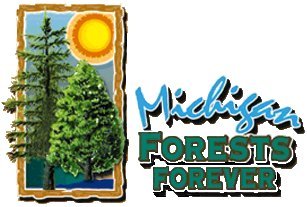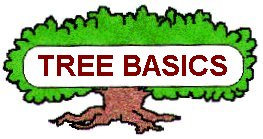

Home Page |
MICHIGAN FORESTS FOREVER TEACHERS GUIDE
| TREE BASICS SECTION |  |
This section covers topics not addressed in the CD ROM, but are important aspects of natural resource management and understanding some of the background needed to fully appreciate where we are today. This section includes six areas of enrichment, each with exciting possibilities for classroom application. This section covers a lot of information.
What is a
forest?
Michigan forest descriptors
A tree identification primer
ID
Characteristics
State
Species List
How to Use
Dichotomous Keys
Tree ID
websites
Tree
ID Glossary
Michigan forest history
Land survey
Map & Compass
U.S. Forestry Trends
Fast Fun Forest Facts
Forest: "an ecosystem characterized by a more or less dense and extensive tree cover, often consisting of stands varying in characteristics such as species composition, structure, age class, and associated processes, and commonly including meadows, streams, fish, and wildlife -- note: forests include special kinds such as industrial forests, non-industrial private forests, plantations, public forests, protection forests, and urban forests, as well as parks and wilderness." -Society of American Foresters |
This is a simple question with a variety of different answers. Try asking your class to write a paragraph or two that describes a forest! You’ll likely find a wide variety of perceptions.
For the purposes of the Michigan Forests Forever project, we will consider a forest an ecosystem dominated by trees, together with all the animals and other plants associated with trees. Additionally, forests can include other ecosystems, such as marshes, openings, rock outcrops, sand dunes, streams, ephemeral ponds, and inland lakes.
There are several additional definitions that will help you and your students critically-think about forests. Because different soils vary in their ability to produce forests, the U.S. Forest Service has defined minimum productivity as land capable of growing 20 cubic feet of wood per acre per year. That means many acres of extremely slow-growing forests are NOT considered in the forest inventory. For example, a 100 year old bog spruce stand, where trees are only 10 feet tall and less than two inches in diameter, would not fit the definition of a forest.
The difference between "all forest" and "timberland" needs to be understood because most of the extensive inventory data describe "timberland" and not "all forest". Timberland is land that can grow 20 cubic feet of wood/acre/year, is not withdrawn from harvesting by law or regulation, and is not associated with human developments.
There are other criteria that foresters use to define forests, but they are not as important (arguably) as those mentioned above.
 Forests are complex systems that we do
not fully understand. Nevertheless, forestry employs a variety of management strategies to
increase outputs to meet the demands of society and has 100 years of experience and
research to draw upon. While the process of questioning practices, performing research,
and adapting to new knowledge or conditions is always occurring, few would argue that
forest management has been a key element in the support of our increasing demands on the
forest base and will become increasingly important in the future. If you click on
the thumbnail map on the left, you will see the distribution of forests across the USA.
Forests are complex systems that we do
not fully understand. Nevertheless, forestry employs a variety of management strategies to
increase outputs to meet the demands of society and has 100 years of experience and
research to draw upon. While the process of questioning practices, performing research,
and adapting to new knowledge or conditions is always occurring, few would argue that
forest management has been a key element in the support of our increasing demands on the
forest base and will become increasingly important in the future. If you click on
the thumbnail map on the left, you will see the distribution of forests across the USA.
| Activity Suggestions Describe A Forest PLT - Poet-Tree Chart The Forest |
Michigan Forest Descriptors
Forests or aspects of forest ecology can be described in many ways. A person can look at the forest today, or look at trends over time. In order to understand how forests are managed, we must first understand what the forest is. In a nutshell, Michigan forests are in great shape and getting better (by most measures). Trees are older, larger in size, moving towards later successional stages, and providing abundant opportunities for wood production, wildlife habitat, recreation experiences, and maintenance of high water quality and soil protection. Some of the most important measurements include;
Where Do Forest Data Come From?
The U.S. Forest Service is charged by Congress to inventory the nation’s forests on a regular basis. The first comprehensive Michigan inventory was done in 1935 and has been repeated four times since then, with the most recent inventory completed in 1993. Statewide in 1993, there were 10,852 forest sample plots, of which 6,824 were measured in the field. From these data, referred to as "FIA" data, a huge amount of information about Michigan forests was gathered and analyzed.
In addition to FIA data, various ownerships will have at least one kind of forest inventory. Public and industrial lands have large amounts of information. Private, non-industrial forest ownerships have the least amount of information
Forest inventory data provide many excellent classroom opportunities to describe aspects of the forest with graphs, charts, and tables. Much of this data is available on the U.S. Forest Service website: http://fia.fs.fed.us/, but it is not the most intuitive site to manipulate. It helps to have a good understanding of forest inventory terms and the nature of the FIA data.
Tree Identification Primer
Tree identification is a basic component to understanding forests and forest ecology. Forests are dominated by trees. The trees largely determine the characteristics of other ecological components, such as wildlife habitat, soil type, water cycles, etc. Of course, all the other ecological characteristics impact trees, too. Nevertheless, when we talk about forests, trees are the best place to begin. Knowing the species is a good first step in learning about each of their individual sets of environmental requirements. Beyond that, there are many aspects of forests that can be explored.
For more information about tree identification, try these links.
ID Characteristics
State
Species List (U.S. Forest Service Inventory)
How to Use
Dichotomous Keys
Tree ID
websites
Tree
ID Glossary
| Activity Suggestions PLT Name That Tree Get To Know A Tree |
 |
This website was developed and created by Michigan State University Extension for the teachers of the State of Michigan. |
Page Name:
TreeBasics/TreeBasics.htm